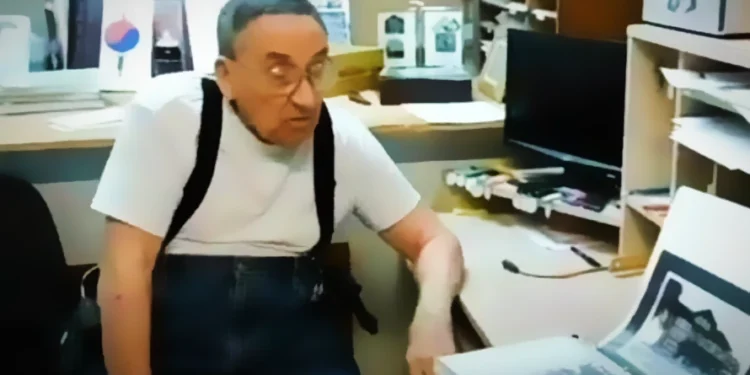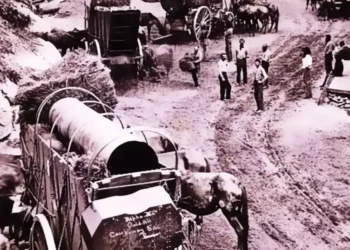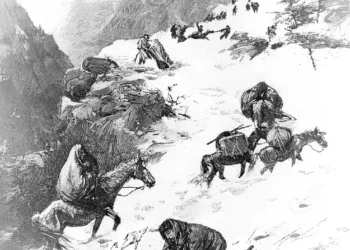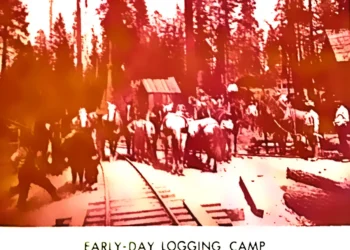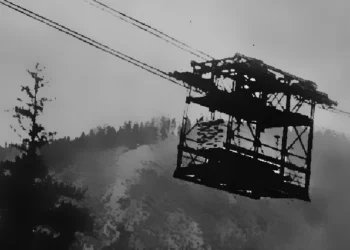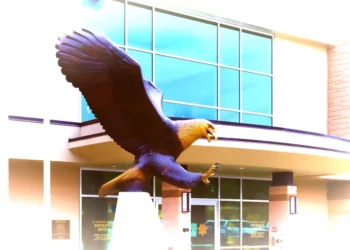By Cris Alarcon, El Dorado County News | May 23, 2025
RESCUE, Calif. — Francis Merritt “Carp” Carpenter, a cornerstone of the Rescue community and a lifelong steward of El Dorado County’s rich history, passed away on April 29, 2025. He was 95.
Affectionately known as “Mr. Rescue,” Carpenter was born June 7, 1929, in El Dorado County. Over the course of nearly a century, he became an enduring symbol of civic pride and historical preservation in the Sierra Nevada foothills. His death marks the end of an era for many in the tight-knit community of Rescue, where he spent a lifetime collecting stories, honoring the past, and inspiring residents to value their local heritage.
Carpenter’s commitment to the community was immortalized in the 2022 documentary Francis ‘Carp’ Carpenter – Mr. Rescue, available on YouTube. The film offers a heartfelt portrayal of his life, capturing his deep involvement in local civic efforts, historical preservation, and his beloved role as an unofficial town historian.
“Carp didn’t just remember history—he made sure we wouldn’t forget it,” said Tom Heflin, a longtime friend and fellow historical society member. “He believed every story mattered, and he made it his mission to honor the people who came before us.”
Throughout his life, Carpenter collaborated with local museums, schools, and civic organizations to share the often-overlooked narratives of Rescue and surrounding communities. He led tours, gave lectures, and volunteered for decades—his encyclopedic knowledge and easy smile making him a favorite among residents young and old.
According to the El Dorado County Historical Society, Carpenter’s archives and oral history recordings are expected to become part of the society’s permanent collection.
“His documentation of Rescue’s people and places is invaluable,”
said Society President Lisa Cummings.
“We’ve lost a dear friend and a walking archive.”
Carpenter was laid to rest in El Dorado County, where generations of locals continue to benefit from his lifelong labor of love. He is survived by extended family and countless community members who considered him part of their own.
Francis Merritt “Carp” Carpenter: The Legacy of El Dorado County’s “Mr. Rescue”
Francis Merritt “Carp” Carpenter, affectionately known as “Mr. Rescue,” was a stalwart figure in El Dorado County, California, whose life’s work was dedicated to preserving and sharing the rich tapestry of local history. Born on June 7, 1929, in the heart of the Sierra Nevada foothills, Carpenter’s deep roots in the community spanned nearly a century, during which he became an invaluable resource for historians, educators, and residents alike.
A Life Steeped in Local History
Carpenter’s passion for history was ignited at a young age, influenced by his family’s longstanding presence in the region. His great aunts, Myra and Mina Carpenter, were among the early settlers of the area, and their legacy inspired him to delve into the past. Over the years, he amassed an extensive collection of photographs, documents, and artifacts that chronicled the development of Rescue and its surrounding communities.
In 2022, Carpenter’s dedication to local history was showcased in the documentary “Francis ‘Carp’ Carpenter – Mr. Rescue,” which highlighted his efforts to preserve the stories of the past and share them with future generations. The film featured interviews with Carpenter and showcased his vast collection, providing a glimpse into the daily lives of early residents and the evolution of the region.
Preserving the Past for Future Generations
Beyond his role as a historian, Carpenter was a community advocate who believed in the importance of education and shared knowledge. He often opened his home to visitors, offering guided tours of his collection and sharing stories that brought the past to life. His efforts were instrumental in fostering a sense of pride and connection among residents, reminding them of the rich history that shaped their community.
In the words of a local historian, “Carp was more than a keeper of history; he was a bridge between the past and present, ensuring that the stories of our ancestors were never forgotten.”
A Lasting Legacy
Francis Merritt “Carp” Carpenter passed away on April 29, 2025, at the age of 95. His legacy, however, endures through the countless stories he preserved and shared, and the community he helped build. His contributions to El Dorado County’s historical narrative remain a testament to his dedication and love for his hometown.
For those interested in delving deeper into Carpenter’s life and work, the documentary “Francis ‘Carp’ Carpenter – Mr. Rescue” offers an in-depth look at his contributions to preserving the history of Rescue, California.
In a quiet moment thick with nostalgia, a local family historian walks a visitor through a box of irreplaceable photographs—each one a visual thread stitched into the fabric of El Dorado County. From the Sunrise Roadhouse near Ponderosa to the original Green Valley mill camps of Pino Grande, the images reflect generations of loggers, carpenters, and resilient women like Myra and Mina. Some faces are familiar, others still a mystery, prompting an urgent call to preserve names and stories before they vanish. There’s Uncle Fred, a trapped bear, postcards with no addresses, and even an airplane landing on Deer Valley Road—all reminders that history isn’t found in books alone, but in the hands of those who lived it and the hearts of those who remember.
Francis Merritt “Carp” Carpenter: The Memory of Rescue and El Dorado County
In the quiet foothills of the Sierra Nevada, where history lives in the weathered faces of old photos and the stories passed down through generations, one man stood as a living bridge between past and present: Francis Merritt “Carp” Carpenter (1929–2025). Known affectionately as “Mr. Rescue,” Carp was more than just a local historian — he was the heartbeat of a community determined never to forget its roots.
Born and raised in El Dorado County, Carp embodied the spirit of Rescue, a small town steeped in the legacy of logging camps, roadhouses, and pioneer families. From his earliest days, Carp was drawn to the tales etched into every weathered photograph and the faint imprints of lives lived long ago.
A Keeper of Family and Community Stories
Carp’s family was woven tightly into the fabric of El Dorado County’s history. Photographs he preserved featured his great aunts Myra and Mina Carpenter, his grandmother Mary, and countless relatives who toiled in the nearby woods. Many of these relatives had made their living as loggers, working alongside steam engines that hauled towering pines and shaped the very landscape Carp called home.
Among the sepia-toned memories were images of roadhouses and boarding houses at key crossroads like Sunrise House, Ponderosa, and Green Valley — places where weary travelers paused and community ties were forged. Carp could point to a faded postcard of the original Rescue Bridge, under construction long before the highways reshaped the region, or recount stories of the bears that roamed the forests, sometimes catching an unwelcome meal from garbage cans near homes.
“Those photos aren’t just pictures,”
Carp once said.
“They’re the echoes of people who built this place. I want to make sure their stories aren’t lost.”
Mr. Rescue: A Life Devoted to Preserving Local Heritage
Carp’s devotion went beyond collecting photos and names. As a respected community advocate, he worked tirelessly to keep Rescue’s history alive through public talks, local archives, and personal storytelling. His passion caught the attention of filmmakers, culminating in the 2022 documentary Francis ‘Carp’ Carpenter – Mr. Rescue, which showcased his lifelong dedication and deep love for El Dorado County’s heritage.
Friends and neighbors recall Carp as a walking encyclopedia of local lore, able to identify nearly every face in a century-old photograph, recount the history of forgotten roads, and describe the lives behind the faded postcards. His connection to the community was so strong that many turned to him as a living link to their own family histories.
A Legacy Etched in Time
Carp entered his 95th year surrounded by the very landscape that had shaped his life and the lives of those who came before him. He passed away peacefully on April 29, 2025, leaving behind a legacy of preservation and pride.
The archives he built, the stories he told, and the photos he carefully labeled remain invaluable to El Dorado County — a testament to a man who understood that history is not just about dates and places, but about people and their enduring spirit.
For those wanting to know more about Francis Merritt “Carp” Carpenter and his impact, the documentary Francis ‘Carp’ Carpenter – Mr. Rescue offers an intimate glimpse into a life lived in service to community memory.
The Roadhouse and Early Settlements
Among the earliest landmarks was the Sunrise Roadhouse, located near Ponderosa and Green Valley roads. Described as “as close to the road as you could get,” the Roadhouse was a hub for travelers and locals alike. While details remain sparse, it is clear that this establishment served as a vital waypoint—a boarding house or roadhouse that offered rest and refuge in the rugged terrain.
Family Faces and Forgotten Names
The photographs feature a mix of relatives and unknown figures. Names like Myra and Mina Carpenter, great aunts, and “Grandma Carpenter” bring the family’s past into sharp relief. Yet, many images remain unidentified, highlighting the urgency to document and preserve these connections before they fade into obscurity.
One poignant detail is the careful notation of names on the backs of copies to maintain their histories, an effort to fight the inevitable loss of memory that time brings.
Logging Life and the Woods
A dominant theme in the collection is the prominence of logging and forestry work. Multiple photos depict family members—uncles and great-uncles—working as loggers around Pino Grande and Final Grand. Steam engines used for hauling logs are captured, underscoring the hard labor and industry that supported the local economy.
Wildlife Encounters and Daily Life
The collection also offers glimpses of daily life and the surrounding wilderness, including striking images of bears caught in traps—a reminder of the untamed environment these families lived alongside. Stories about bears raiding garbage cans bring a human, humorous touch to the harsh realities of rural living.
Postcards and Roadside History
Among the images are postcards from the early 1900s, some without addresses but with vivid scenes of Rescue, Green Valley, and routes to Lake Tahoe. These postcards reveal how communication and memory were preserved before modern conveniences. The original cameras and photographic techniques used by the family add another layer to this rich visual history.
Bridges, Roads, and Changing Landscapes
Photographs of early bridges and roads show the evolving infrastructure, such as the construction of the Green Valley Road bridge near Rescue and the “quick” crossing where cars once had to ford creeks. These snapshots illustrate how the community adapted and grew with time.
Oral History – Life in Rescue, CA
A Living Archive
This collection of photographs and stories is more than nostalgia—it’s a living archive of El Dorado County’s cultural and economic roots. The Carpenter family and their extended relations serve as guardians of history, passing down knowledge that might otherwise be lost. Their efforts remind us that history is preserved not just in books but through photos, names, and shared memories.
As these old photos continue to be studied and cataloged, the hope is that more faces will be identified, more stories told, and the legacy of these families will endure for generations to come.
Interview with Francis Carpenter
Rescue, California | 2024
Q: How long have you been here on this property?
Francis: Sixty-plus years.
Q: And your original house—it burned down, right?
Francis: Yes, it was right where that mobile home is now. The house burned down, oh… I’d say around 1966.
Q: And the shop? How long has that been here?
Francis: That little shop was here when the house burned. I had just expanded on it. Eventually, I added the roof cover and other improvements as I needed them.
Q: I noticed some tracks out here—tell me about that little train you had.
Francis: Well, I had three grandkids living just over the hill, and two more in the other direction, all within walking distance. So I built a track and a little pushcar for them. That cart behind you fits right on the rails—they’d take turns pushing each other around. It circles the house and even has a siding switch over there.
Q: And where did the track come from?
Francis: Everywhere! I didn’t buy it new. Old gold mines had discarded pieces—I’d bring them home and weld them together. This track came from places like the Bowler Mine and another site on the river, near some BLM land we had next to our property. Most of the time, the old-timers left the rails behind. I just gave them a second life.
Q: Looks like your grandkids had some fun here.
Francis:
Oh, they did. They could just walk up anytime they wanted to visit. They loved that track.
Q: Tell us about this old Dodge over here.
Francis:
That’s a 1923 Dodge. It was running when I parked it—not now though. My brother got it, supposedly from a group of Native Americans in Nevada. I got it from him later.
Q: And this Model A pickup in the back?
Francis: That’s a 1927 Model A. It still runs—just needs a battery and some gas. That one actually belongs to my niece.
Q: Is that a mailbox from the Rescue Post Office?
Francis: Sure is. It’s one of the original personal mailboxes from the post office before they remodeled and replaced them.
Q: What’s that piece of equipment up there—looks like a plow?
Francis: No, that’s a buggy tongue for a single-horse buggy. You hitch one horse between the poles. Above it is a tongue from a big wagon—you’d put a horse on each side for that.
Q: Your family’s property goes back even across the road, right?
Francis:
Yeah, my brother lived over there. Most of this land was all part of the same family holdings.
Q: You used to talk about a milkman and a vegetable man coming up Green Valley Road.
Francis: Oh yes. Back in the day, we had several delivery folks. One was a vegetable man—can’t quite recall his name, but he was known to locals. His English was broken, and if you asked his name, he’d just smile and say “me.” He had a Dodge screenside truck, factory-made with screened compartments in back, and sometimes drove a Model T. Came once a week, parked out front, and honked. Fresh vegetables, probably picked that morning.
Q: I heard you raised chickens too?
Francis: That we did. Around the time of World War II, my father got into poultry. We had about a thousand laying hens—white leghorns—and sold our eggs through the Sacramento Poultry Producers. They always took them and paid market price.
Q: Do you remember how much eggs sold for back then?
Francis: No, can’t say I remember. We never bought eggs ourselves—had more than enough.
Q: Did you raise any other types of chickens?
Francis: Sure. We also raised fryers—meat birds. You could buy chicks sexed to be mostly hens for laying, or buy roosters in the summer for meat. We did both.
“This one? You’d put a little rock in here and crush it,” he said, gesturing to the old ore stamper. “Then pan it, weigh it… see what you’ve got. That electric motor came later. But that’s how you tested the gold claim—you brought in a bucket of ore and asked, ‘What’s it worth?’”
“That sluice box—my brother took it down into the creek every winter. Never said a word. Took out hundreds in gold, ounce by ounce, soon as the rains slowed down.”
“Cowbells? They vanish. Folks pick ’em up. Like the branding iron from the Linderman Ranch—2,000 acres—just one left. All the rest disappeared. Still don’t know who the ‘L’ brand belonged to. Ain’t ours.”
“Great-Grandpa Carpenter ran a store in Shingle. Published the town newspaper too. Then moved here to Rescue around 1894. The post office opened in ’95. That’s where our story roots down.”
“My mother was the youngest of 15. Born into the Luna family. Bought the Sunrise House on Ponderosa and Green Valley Road back in 1877. Paid $800. Jake Egger was gettin’ out of the roadside business. We just stayed put.”
On Selling Chickens and Roadside Commerce:
We bought about 50 chickens or so. The old house was right on the road—people would just stop, ask for water, maybe buy a chicken. The foreign chickens, you know, because the kids could handle the selling—you just put the bird in a gunny sack, poked a hole in it for the head to stick out, collected your money, and off they went.
Do you remember how much you charged for the chickens back then?
Oh, no idea. Pretty cheap, I’d guess.Was that on this property?
No, that was across from the firehouse by the store in Rescue. That’s where the old house was—the one we tore down. It brought tears to my eyes, tearing it down. It was probably built around 1850, maybe during the Gold Rush. We hadn’t done much maintenance on it. Eventually, it became a danger.We moved my mom into a mobile home we set up out back. The house was just falling apart by then.
On Raising Livestock and Selling Dairy:
Back then, we had a dozen milk cows and raised chickens. We’d ship cream—no refrigeration, so milk was moved daily. Cream was shipped once a week in cans. If it soured, you could still sell it, just a few cents less per pound than sweet cream. We sold butter to Crystal Creamery—yep, I think they’re still around. You’d take eggs to Poultry Producers on lower Broadway and deliver cream and butter to Crystal.
They were picky about eggs. Every crate was checked—cracks, dirt, brown eggs mixed with whites. They wanted clean, medium-sized, white eggs. The others—brown, cracked, or double-yolks—went to commercial buyers.
Who bought your chickens?
Anybody and everybody. One of our best customers was CDF—the California Department of Forestry. They’d buy a dozen frying chickens. We’d get a state check later. But those poor firefighters—they had to skin and clean them themselves!
On Deer, Roadkill, and CDF Work:
Anything I ever did with CDF, I could handle a deer—skin it, hang it up, butcher it. I did it all the time later on, especially up north. That was popular work in the orchards. A lot of deer and roadkill out that way.
On Jake Egger’s Chair and Historic Furniture:
This chair here—it’s got some history. It belonged to Jake Egger. They lived where Dragons Road crosses Weber Creek. That was the Egger place. When Jake got old, one of my uncles brought him up to the Luna Ranch to live out his last three years so he wouldn’t be alone. That chair came with him. He’d sit out on the porch in it.
Is it handmade or imported?
What you see is what you get. Looks handmade to me. Some of my cats messed with the paint, though—kind of makes me mad.
On Deer Horns and Hunting:
All those deer horns—those are from my dad, my uncle Bill across the road, and some from my son. We never threw a single one away. Some of those horns came from Nevada, Montana—but most are local.
On Old Kerosene Cans and Stamp Mills:
Those old cans? Kerosene. You’d get about a gallon from the store in Rescue, and it’d last you a good 40 nights with a kerosene lantern. I think I might still have one lantern somewhere.
That stamp mill piece came from the Jurgens Mine, down on Weber Creek. It was used to crush ore. That’s one of the last things I brought in. Real history, that one.
For those interested in delving deeper into Carpenter’s life and work, the documentary “Francis ‘Carp’ Carpenter – Mr. Rescue” offers an in-depth look at his contributions to preserving the history of Rescue, California.
READ MORE ABOUT RESCUE HISTORY

